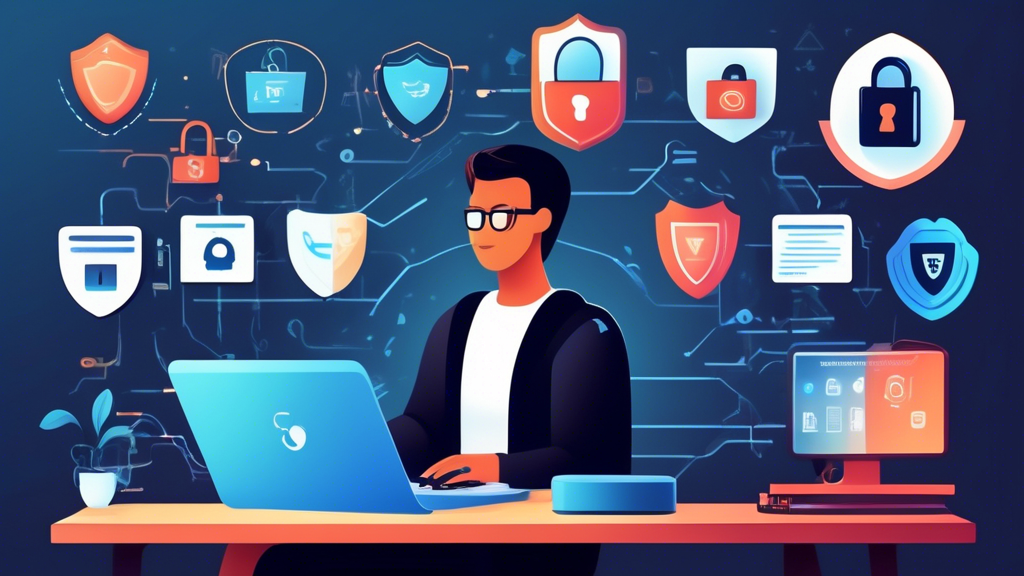Top Strategies to Protect Internet Privacy
With the increasing reliance on the internet for communication, work, and entertainment, protecting your internet privacy has become more crucial than ever. Cyber threats and data breaches are rampant, making it essential to adopt effective strategies to safeguard your personal information. This article explores the top strategies to protect internet privacy, ensuring a safer and more secure online experience.
From strengthening your passwords to utilizing Virtual Private Networks (VPNs) and being cautious with personal information on social media, these strategies will empower you to take control of your online security. By implementing these measures, you can significantly reduce the risk of unauthorized access and protect your sensitive data from potential threats.
1. Strengthen Your Passwords and Use Two-Factor Authentication
One of the most fundamental steps to protect internet privacy is to create strong, unique passwords for each of your online accounts. A strong password typically includes a mix of uppercase and lowercase letters, numbers, and special characters. Avoid using easily guessable information such as birthdays or common phrases, and never reuse passwords across different sites.
To manage your passwords more effectively, consider using a password manager. These tools help generate, store, and autofill complex passwords, reducing the likelihood of security breaches. In addition to strong passwords, enable Two-Factor Authentication (2FA) wherever possible. 2FA provides an extra layer of security by requiring two forms of verification before granting access to your accounts, making it significantly harder for cybercriminals to gain unauthorized access.
2. Utilize Virtual Private Networks (VPNs)
Virtual Private Networks (VPNs) are an excellent tool for enhancing your online privacy. A VPN encrypts your internet traffic, making it almost impossible for hackers, ISPs, or any unauthorized parties to intercept and read your data. By masking your IP address, VPNs also help you browse the internet more anonymously, enhancing your overall privacy.
When choosing a VPN service, look for one with a strong reputation for security, no-logs policy, and high-speed servers. Reliable VPNs ensure that your data is protected, even when you’re connected to public Wi-Fi networks, which are often vulnerable to security threats.
3. Be Cautious with Personal Information and Social Media
Oversharing personal information on social media platforms can significantly compromise your internet privacy. Cybercriminals often use information obtained from social profiles to launch phishing attacks or commit identity theft. To protect yourself, regularly review and adjust your privacy settings on social media platforms to control who can see your information.
Be wary of accepting friend requests from unknown individuals and avoid clicking on suspicious links or attachments sent via social media messages. Additionally, limit the amount of sensitive information you share online and be mindful of what you post to prevent exposing yourself to potential risks.
By following these top strategies, you can effectively protect your internet privacy and enjoy a safer online experience. Stay vigilant, adopt best practices, and leverage the available tools to keep your personal information secure in today’s digital age.
Strengthen Your Passwords and Use Two-Factor Authentication
In today’s digital age, maintaining robust internet privacy is paramount. One of the foundational steps to protect internet privacy is to strengthen your passwords and leverage two-factor authentication (2FA). This section will delve into the importance of creating strong, unique passwords for each of your online accounts, the utility of password managers, and the added layer of protection that two-factor authentication provides.
The Importance of Strong, Unique Passwords
Passwords are often the first line of defense against unauthorized access to your online accounts. Using simple or commonly used passwords can leave your personal information vulnerable to cyberattacks. Hackers employ various methods, such as brute force attacks and password databases, to crack weak passwords with ease.
To counter this, it’s essential to create strong, unique passwords for each of your online accounts. A strong password typically includes a combination of uppercase and lowercase letters, numbers, and special characters. Avoid using easily guessable information, such as birthdays, common words, or sequences like 123456 or password.
How to Use Password Managers for Better Security
Remembering a multitude of complex passwords can be challenging. This is where password managers come in. Password managers are tools that securely store and organize your passwords, allowing you to generate and retrieve strong passwords without the need to remember them.
When choosing a password manager, consider features such as strong encryption, ease of use, and cross-platform compatibility. Popular password managers like LastPass, Dashlane, and 1Password offer robust features that simplify the process of maintaining strong, unique passwords for all your accounts.
By using a password manager, you not only enhance your security but also save time and reduce the stress of password management. The tool can automatically generate secure passwords for new accounts, fill them in when logging in, and even alert you if any of your stored passwords have been compromised.
The Added Layer of Protection Provided by Two-Factor Authentication (2FA)
Even with strong passwords, there’s always a residual risk of credential compromise. This is where two-factor authentication (2FA) can provide an extra layer of security. 2FA requires not just a password but also a second form of verification, which can be something you have (like a phone), something you are (like a fingerprint), or something you know (another password or PIN).
Common forms of 2FA include:
- SMS Verification: Once logged in with your password, you receive a text message with a verification code that you must enter.
- App-Based Authentication: Authentication apps like Google Authenticator or Authy generate time-sensitive codes that you need to enter after your password.
- Hardware Tokens: Physical devices like YubiKeys provide a unique code when connected or used.
- Biometric Verification: Methods like fingerprint scanning or facial recognition add a high level of security.
Implementing 2FA on your online accounts can significantly increase your account security, as it makes it much harder for hackers to gain access even if they know your password. Most major services, including email providers, social media platforms, and financial institutions, offer 2FA options. It’s highly recommended to enable 2FA wherever it’s available to ensure enhanced protection of your internet privacy.
Conclusion
Strengthening your passwords and using two-factor authentication are critical steps in safeguarding your internet privacy. Strong, unique passwords prevent unauthorized access, while password managers streamline the process of maintaining them. Adding two-factor authentication introduces an additional layer of defense, making it exponentially more difficult for cybercriminals to penetrate your online accounts. By adopting these practices, you lay a solid foundation for protecting your internet privacy effectively.
Utilize Virtual Private Networks (VPNs)
What Are VPNs and How Do They Work?
Virtual Private Networks, commonly known as VPNs, are essential tools for anyone looking to protect internet privacy. A VPN connects your device to a secure server, creating a private network from a public internet connection. This secure connection encrypts your internet traffic and effectively hides your IP address, thus keeping your online activities anonymous and secure.
When you use a VPN, all of your data funnels through an encrypted tunnel to the VPN server before reaching the internet. This process not only masks your IP address but also protects sensitive data from potential hackers, especially when using unsecured networks like public Wi-Fi hotspots. Therefore, VPNs act as a robust shield against cyber threats, helping you maintain a high level of privacy online.
Benefits of Using a VPN
The most notable benefit of using a VPN is enhanced safety and privacy. Here are some key advantages:
Encryption of Internet Traffic
One of the primary functions of a VPN is to encrypt your internet traffic. This means that anyone attempting to intercept your data will only see a scrambled, unreadable form. Encryption is particularly crucial when handling sensitive data, such as online banking or private communications, ensuring that your information remains confidential and secure.
Hiding Your IP Address
By masking your real IP address and replacing it with the IP address of the VPN server, your online actions cannot be traced back to you. This is particularly beneficial for maintaining anonymity, avoiding targeted marketing, and bypassing geographical restrictions on certain websites and streaming services.
Secure Browsing on Public Wi-Fi Networks
Public Wi-Fi networks, such as those in coffee shops, airports, and hotels, are notoriously susceptible to cyber-attacks. Using a VPN on these networks creates a secure, encrypted connection between your device and the internet, greatly reducing the risk of data theft. This safeguard ensures that your credentials, credit card information, and other sensitive data are protected from potential eavesdroppers.
Access to Restricted Content
Geographical restrictions can limit access to various websites and services based on your location. A VPN allows you to connect to servers in different countries, bypassing these restrictions and providing access to a more open and uncensored internet. This capability is especially useful for travelers and those who wish to access content from their home country while abroad.
Tips on Choosing a Reliable VPN Service
Given the multitude of VPN services available, selecting a reliable one can be a daunting task. Here are some tips to help you choose the best VPN to protect internet privacy:
Check the Encryption Protocols
Make sure the VPN uses strong encryption protocols, such as OpenVPN or WireGuard. These protocols offer robust security and are widely recognized for their effectiveness in protecting data.
Evaluate the Logging Policy
A trustworthy VPN service should have a strict no-logs policy, meaning they do not store any records of your online activities. This is crucial for ensuring that your privacy is maintained even within the confines of the VPN service.
Assess Connection Speeds
While all VPNs may slow down your connection to some extent, high-quality VPNs minimize this impact. Look for services that offer excellent connection speeds so you can browse, stream, and download without noticeable lag.
Consider Multi-Device Support
Ensure the VPN service supports multiple devices and operating systems, allowing you to protect all your gadgets simultaneously. This is especially useful for households with multiple internet-connected devices.
Test Customer Support
Excellent customer support is essential, particularly if you encounter any technical issues. Opt for VPN providers that offer 24/7 customer service through various channels, including live chat, email, and phone.
Read User Reviews
Finally, take time to read user reviews and expert analyses. These can provide valuable insights into the strengths and weaknesses of different VPN services, helping you make a well-informed decision.
By carefully selecting a dependable VPN service and understanding its benefits, you can significantly enhance your internet privacy and protect your sensitive information from prying eyes. Utilizing a VPN is a pivotal step in shielding your online presence and enjoying a safer, more private internet experience.
Be Cautious with Personal Information and Social Media
In the digital age, social media platforms have become an integral part of daily life for millions of people worldwide. While these platforms offer great opportunities for connection and self-expression, they also pose significant risks to your internet privacy. Being vigilant about the personal information you share online is essential to protect internet privacy effectively.
The Risks of Oversharing
Social media sites encourage users to share personal details, from birthdays and addresses to daily routines and travel plans. While sharing such information might seem harmless, it can be exploited by cybercriminals for a variety of nefarious purposes, including identity theft and social engineering attacks. Oversharing can also expose you to physical threats, as malicious actors might use the shared information to track your whereabouts and activities.
Adjust Privacy Settings
One of the simplest yet most effective ways to protect internet privacy on social media is by adjusting your privacy settings. Most platforms offer various options to control who can see your posts, photos, and personal information. Take the time to review and update these settings to ensure that your content is visible only to trusted friends and family. For instance, Facebook allows you to customize the audience for each post, while Instagram offers options to make your account private.
Be Wary of Phishing Scams
Phishing scams are prevalent on social media, where attackers often pose as legitimate contacts or companies to trick users into revealing sensitive information, such as passwords and credit card numbers. Be vigilant for signs of phishing, such as unsolicited messages containing suspicious links or requests for personal details. Always double-check the sender’s information and avoid clicking on links or downloading attachments from unknown sources.
Limit the Exposure of Sensitive Data
Even with stringent privacy settings, it’s advisable to be selective about what you share online. Avoid posting sensitive information such as your home address, phone number, or financial details. Additionally, refrain from sharing personal identifiers like your Social Security number or passport details. If such information falls into the wrong hands, it can lead to severe consequences like identity theft and financial fraud.
Regularly Monitor Your Online Presence
Another crucial aspect of protecting internet privacy is to regularly monitor your online presence. Conduct periodic searches of your name to see what information is publicly available. This allows you to identify and address any unwanted exposure of personal data. Social media platforms and search engines often update their privacy policies, so staying informed about the latest changes can help you make necessary adjustments to your privacy settings.
In conclusion, being cautious with personal information and social media activities plays a vital role in safeguarding your internet privacy. By following best practices such as adjusting privacy settings, being wary of phishing scams, limiting the exposure of sensitive data, and monitoring your online presence, you can significantly reduce the risks associated with online interactions and better protect your internet privacy.
Conclusion
Protecting your internet privacy has never been more crucial in our digitally interconnected world. By implementing strong, unique passwords and leveraging two-factor authentication, you can significantly reduce the risk of unauthorized access to your online accounts. Utilizing Virtual Private Networks (VPNs) adds an extra layer of security by encrypting your internet traffic and masking your IP address, ensuring safer browsing experiences, especially on unsecured public Wi-Fi networks.
Equally important is maintaining vigilance with the personal information you share online, particularly on social media platforms. By adjusting privacy settings, staying aware of potential phishing scams, and limiting the exposure of sensitive data, you can safeguard your personal information more effectively.
By adopting these strategies, you can better protect your internet privacy, ensuring a safer and more secure online presence. Remember, the responsibility of protecting your personal information lies with you, and taking proactive steps can make a significant difference.









